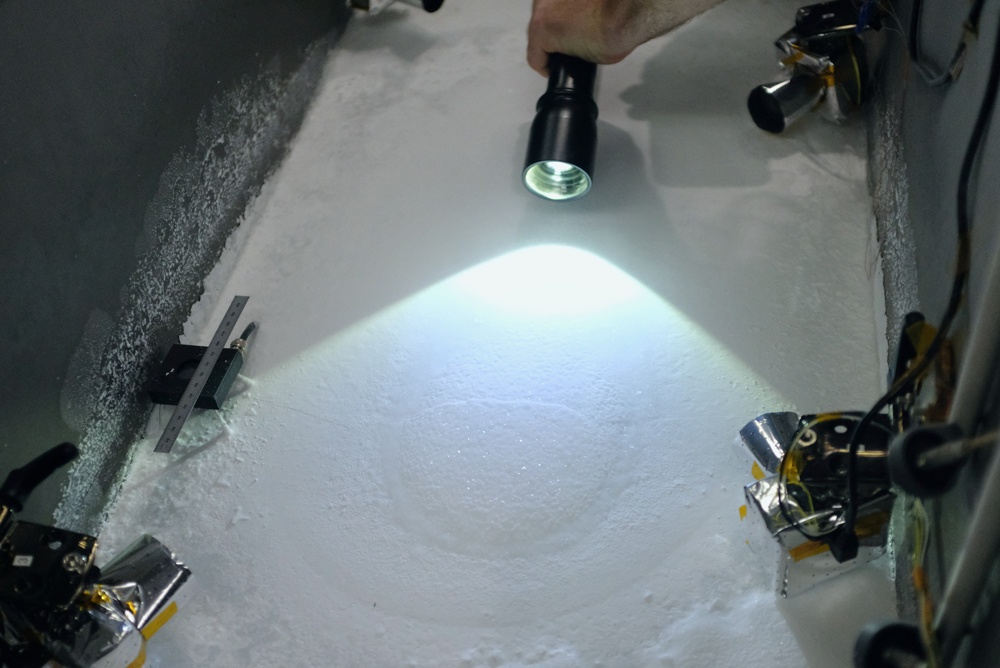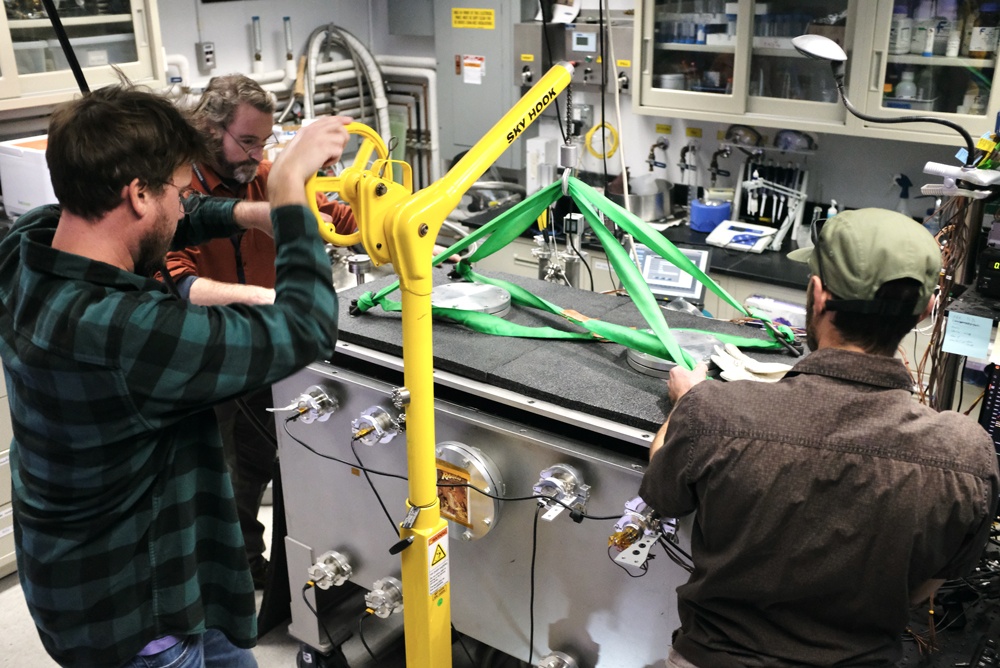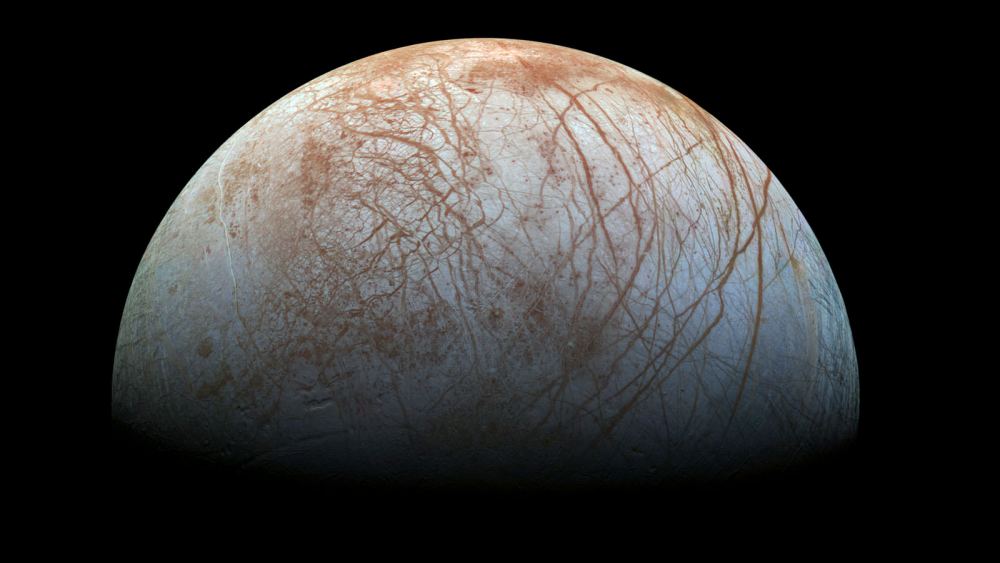What’s the best way to learn about Europa before we actually land a mission there? A team of scientists at NASA’s Jet Propulsion Laboratory created a mini version of this icy world in the lab. It’s giving them some fascinating insights into how that moon’s icy surface behaves and providing useful information for planners of the upcoming Europa Clipper flyby mission.
The simulation chamber is called “The Ark” and it’s at the heart of the Ocean Worlds Lab, directed by planetary scientist Kevin Hand. The test chamber is so named because it resembles the Ark in Indiana Jones and the Raiders of the Lost Ark. It has just finished a six-month experiment bombarding a simulated ice surface with solar radiation on a Europan day-night cycle. The idea is to expose the types of ice known to exist on that moon to different radiation environments and see how the ices react. This simulates what Europa Clipper could measure, and also help scientists as they build instruments that will measure various aspects of the moon’s surface.

Simulating Oceans of Many Worlds
The Ocean Worlds Lab does a number of different experiments and computer models to simulate conditions in the oceans of worlds including Europa. “We use a variety of instruments and ultra-high vacuum chambers to investigate ices, salts, silicates, organics, and even microbes under conditions comparable to Europa’s surface,” said Hand. That includes the Ark. It uses a vacuum chamber to study the shape of ice, and how it changes under different temperatures, pressures, and simulated lighting conditions. An array of cameras in the chamber capture images for observation via time-lapse photography. Some of the Ark’s experiments can last for months, which really tests the equipment, too.
“The Ark is one of the only chambers on Earth with a large internal environment built to simulate Europa’s surface,” said Hand. “The Galileo mission revealed that the surface of Europa is telling a story not only about Europa’s subsurface, but also about how the surface changes as a result of temperature, pressure, and irradiation. Cameras, radar, and spectrometers on Europa Clipper will show us much more about the nature and structure of Europa’s ice.”

Temperatures inside the Ark can go as low as 40 Kelvin (-387.67 F), which can be too cold for some experiments. So, the team runs it a little warmer to see changes in the morphology (or shape) of the ice. This more closely simulates some of the surface changes Europa Clipper will see during its visit to Jupiter’s moon. It averages around 110 Kelvin (-260 F) at the equator and about 50 Kelvin (-370 F) at the poles.
Aiming for Europa
Why go to all this trouble to simulate Europa? It’s such a special case because this Jovian moon contains an ocean underneath its icy crust. The Clipper’s main goal is to look for conditions suitable for life at Europa. That means measuring its features and understanding what’s happening inside. It includes the chemistry of the ice and ocean, as well as details about the deep interior of the moon.
Europa Clipper is not a life-detection mission. That remains a goal for a future lander. Think of the Clipper as a broad survey of the moon. It will orbit Jupiter and make nearly 50 flybys of Europa. It should do close approach passes at altitudes of about 25 kilometers (16 miles) above the surface. Eventually, it will scan the entire moon.

The spacecraft will carry cameras and spectrometers to produce high-resolution images and composition maps of Europa’s surface and thin atmosphere. It will also have an ice-penetrating radar to search for subsurface water. A magnetometer and gravity measurements will deliver further information about the ocean and deep interior. The spacecraft will also carry a thermal instrument to pinpoint locations of warmer ice and perhaps recent eruptions of water. Other instruments will measure the composition of tiny particles in the moon’s thin atmosphere and surrounding space environment.
Ice Isn’t the Only Thing the Ark Studies
Still, the idea of finding life on Europa is an exciting one, according to Hand. The existence of subsurface colonies of alien life could have some effect on the icy surface. “Let’s imagine Europa has hydrothermal vents on the ocean floor,” he said. “Would there be any fingerprints of those hydrothermal vents or even organisms on the surface ice of Europa? With the Ark, we’re introducing both hydrothermal vent microbial communities and hydrothermal vent particles into the chambers to see how they get modified, which will enable us to look for those same types of fingerprints on Europa with Europa Clipper.”
The big question will be just how much the simulations at JPL match what the spacecraft sees when it arrives. Europa Clipper is supposed to launch in October 2024 and arrive at the Jupiter system to begin its flybys in 2030. So, everyone will have to wait a few years before the simulations in the Ark are matched by data from the mission.
For More Information
Meet the Team Simulating Europa’s Surface — On Earth
Welcome to the Ocean Worlds Lab
Europa Clipper

